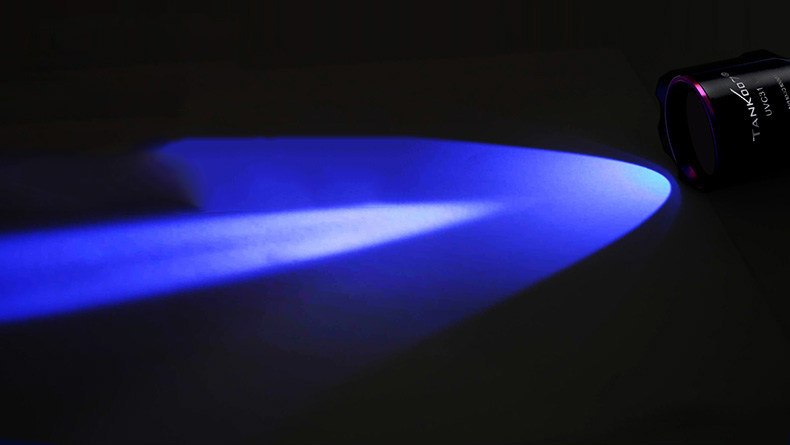UV lamps and handheld UV flashlights are used in industrial curing, non-destructive testing, sterilization, fluorescence detection and other fields.
When we use ultraviolet flashlights, ultraviolet rays can cause damage to human skin and eyes. In addition, ultraviolet rays have the disadvantage of accelerating degradation and aging of plastic materials.
Therefore, the impact of ultraviolet radiation on the human body and materials needs to be considered in places where ultraviolet lamps are used. How do general industries reduce the impact of ultraviolet rays on other items?
TANK007 UV flashlight experts believe that relevant measures can be taken from the following aspects.

Physically shielding UV rays is the most efficient method. Since the penetration of ultraviolet rays is average, aluminum foil or other UV-impermeable materials can be used for physical shielding.
Another measure is to make the coating absorptive or reflective. Choosing a coating that can absorb or reflect UV rays, such as coatings with metal particles that can effectively reflect UV rays, is very effective in preventing materials from being damaged by UV rays.
Some polymers made of special materials have strong UV resistance.
Choose polymer materials with low C=C double bonds, such as polyethylene, fluoropolymers such as polytetrafluoroethylene (PTFE), fluorinated ethylene-propylene (FEP) and polyvinylidene fluoride (PVDF). The material is very resistant to UV damage.
TANK007 engineers tested and found that adding inorganic fillers to polymer materials can absorb ultraviolet photons. This additive can reduce the damage of ultraviolet rays to polymer bonds.
In addition, the most common carbon black and oxide ceramic inorganic materials, including alumina or titanium dioxide, can also significantly absorb ultraviolet rays to reduce damage to polymers. The disadvantage is that these materials destroy the physical properties of the polymer and its color.
As mentioned earlier, inorganic materials are used to absorb excess ultraviolet rays from the ultraviolet lamp site, and organic additives can actually absorb ultraviolet rays. Common antioxidants, UV absorbers, quenchers and free radical scavengers all have the ability to absorb UV rays.
a. Additives that fluoresce – additives that absorb UV rays and dissipate excess UV energy by converting it into heat or emitting at longer wavelengths (fluorescence).
b. Free Radical Scavengers – Free radical scavengers react indirectly with free radicals generated by photochemical or oxidative changes to reduce the chance of damaging polymer chains.
c. Comprehensive addition mainly refers to the flexible selection of organic additives and inorganic additives according to on-site materials. Organic additives require much lower concentrations than inorganic fillers. However, some additives are expensive and can change the properties and processability of certain polymers, and also pose a risk of environmental pollution.
TANK007 Tanke flashlight integrates the research and development, production and sales of UV flashlights. It has focused on the field of UV flashlights for more than 20 years. It is a leader in the UV flashlight industry and has become a long-term partner of many Fortune 500 companies. It is trustworthy!
UV Torch | UV Light Flashlight | Police Flashlight | UV Flashlight Black Light | LED Flashlight Wholesale | UV Flashlight
Copyright 2002-2022 Shenzhen Grandoor Electronics Co., Ltd. (Tank007)粤ICP备10078715号